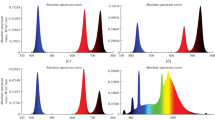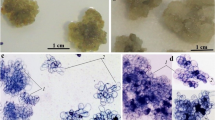Summary
It is possible to obtain autotrophic callus cultures by inhibiting cell respiration. During a first passage of four weeks the cultures synthesized chlorophyll on an agar-medium with a minimum of organic substances such as sugar, amino acids and vitamins. In the second passage these cultures were kept on the same medium but were aerated with a mixture of 99% N2 and 1% CO2. In the third and last passage the medium contained only mineral substances and the same mixture of N2 and CO2 was used for aeration. This pure mineral medium was supplemented with the Hoagland's solution.
These autotrophic callus cultures were grown for about two years under these conditions and showed a growth quotient of ten.
Three different groups of tissues were taken for the 14CO2-fixation. The first group was grown for four weeks on a heterotrophic medium and aerated with O2. This is the socalled respirating group. The second and third group were both aerated with the mixture of N2/CO2 but they were grown on different mediums. One of these groups was grown on a heterotrophic medium for four weeks: these are heterotrophic photosynthesizing tissues. The third group was grown on a pure mineral medium, and these are the autotrophic photosynthesizing callus tissues.
Respirating tissues are different from photosynthesizing cultures in respect to the quantity of light-induced CO2-fixation.
The thin-layer chromatograms reveal the difference between heterotrophic and autotrophic tissues. In the light dependent 14CO2-incorporation the difference is in the amounts of the labelled amino acids glycine and serine. In the dark dependent incorporation the difference is found in the amount of the labelled amino acid aspartic acid. The more autotrophic these tissues are, the higher the level of the CO2-fixation in these amino acids is.
Similar content being viewed by others
Literatur
Bergmann, L.: Wachstum grüner Suspensionskulturen von Nicotiana tabacum var. “Samsun” mit CO2 als Kohlenstoffquelle. Planta 74, 243–250 (1967).
—, Bälz, A.: Der Einfluß von Farblicht auf Wachstum und Zusammensetzung pflanzlicher Gewebekulturen. Planta 70, 285–303 (1966).
—, Berger, Ch.: Farblicht und Plastidendifferenzierung in Zellkulturen von Nicotiana tabacum var. “Samsun”. Planta 69, 58–69 (1966).
Björn, L. O., Odhelius, I.: Chlorophyll formation in exised roots of cucumber and pea. Physiol. Plant. 19, 60–62 (1966).
Cantino, E. C., Horenstein, E. A.: The stimulatory effect of light upon growth and CO2-fixation in Blastocladiella. I. The S.K.I. cycle. Mycologia 48, 777–779 (1956).
Feige, B.: Untersuchungen zum Kohlenstoff- und Phosphatstoffwechsel der Flechten unter Verwendung radioaktiver Isotope. Diss. Würzburg 1967.
—, Gimmler, H., Jeschke, W. D., Simonis, W.: Eine Methode zur dünnschichtchromatographischen Auftrennung von 14C- und 32P-markierten Stoffwechselprodukten. J. Chromatog. 41, 80–91 (1969).
Gautheret, R. J.: Culture du tissue cambial. C. R. Acad. Sci. (Paris) 198, 2195–2196 (1934).
—: La culture des tissue végétaux. Paris: Masson & Cie. 1959.
Hildebrandt, A. C., Wilmar, J. C., Johns, H., Riker, A. J.: Growth of edible chlorophyllous plant tissue in vitro. Amer. J. Bot. 50, 248–254 (1963).
Jaspars, E. M. J.: Pigmentation of tobacco crown gall tissues cultured in vitro in dependence of the composition of the medium. Physiol. Plant. 18, 933 (1965).
Laetsch, W. M., Stettler, D. A.: Chloroplast structure and function in cultured tobacco tissue. Amer. J. Bot. 52, 798–804 (1965).
Murashige, T., Skoog, F.: A revised medium for rapid grwoth and bioassays with tobacco cultures. Physiol. Plant. 15, 473–479 (1962).
Oasson, R., Laetsch, W. M.: Chlorophyll-synthesis in tobacco callus: interaction of sugar and kinetin. Experientia (Basel) 23, 968 (1967).
Roux, E., Tendille, D. A.: Pigments des chloroplastes et photosynthèse. C. R. Acad. Sci. (Paris) 238, 1261–1263 (1954).
Srivastava, B. I. S.: Effect of kinetin on biochemical changes in exised barley leaves and in tobacco pith tissue culture. Ann. N.Y. Acad. Sci. 144, 260–278 (1967).
Stettler, D. A., Laetsch, W. M.: Kinetin induced chloroplast maturation in cultures of tobacco tissue. Sciences 149, 1387–1388 (1965).
Vasil, I. K., Hildebrandt, A. C.: Growth and chlorophyll production in plant tissues grown in vitro. Plant (Berl.) 68, 69–82 (1966).
Venketeswaran, S.: Studies on the isolation of green pigmented callus tissue of tobacco and its continued maintenance in suspension cultures. Physiol. Plant. 18, 776–788 (1965).
Wilmar, J. C., Hildebrandt, A. C., Riker, A. J.: Iron nutrition for growth and chlorophyll development of some plant tissue cultures. Nature (Lond.) 202, 1235–1236 (1964).
Author information
Authors and Affiliations
Additional information
Mit Hilfe der Deutschen Forschungsgemeinschaft.
Rights and permissions
About this article
Cite this article
Corduan, G. Autotrophe Gewebekulturen von Ruta graveolens und deren 14CO2-Markierungsprodukte. Planta 91, 291–301 (1970). https://doi.org/10.1007/BF00387502
Received:
Issue Date:
DOI: https://doi.org/10.1007/BF00387502




